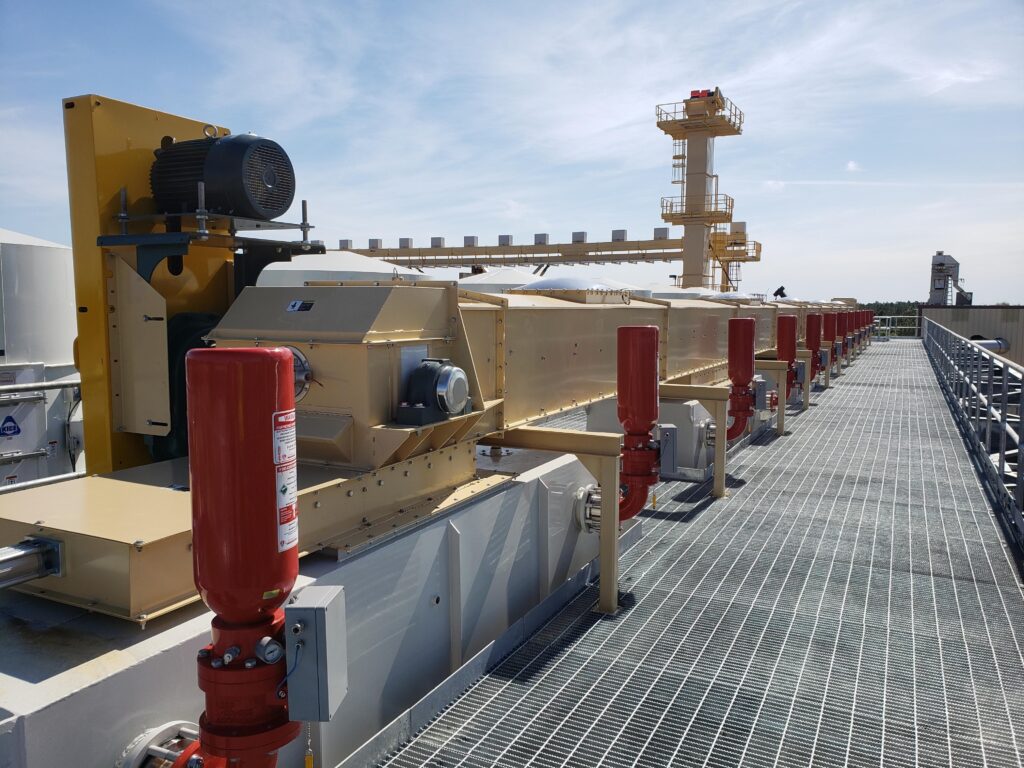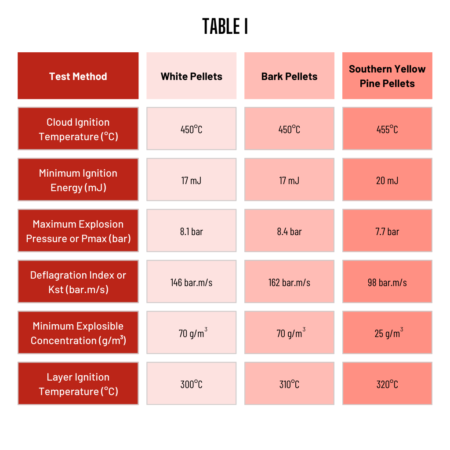
Understanding the hazards and managing biomass dust risks
July 10, 2024
By Jason Krbec, CV Technology
 Explosion suppression bottles and explosion vents (on top of the conveyor) are shown protecting biomass processes.
Explosion suppression bottles and explosion vents (on top of the conveyor) are shown protecting biomass processes. The wood biomass industry often utilizes both softwoods and hardwoods for creating wood pellets. Growing in popularity, wood-based biomass can be categorized as a renewable resource and in some countries has been designated as carbon-neutral fuel source. Choosing a biomass fuel source versus petroleum products can help companies, governments, and others meet sustainability targets and regulations in response to stricter environmental laws. In addition, the improvement of wood-burning technology for generating heat and energy on both a residential- and commercial-scale has contributed to higher demand for wood biomass in recent years.
Higher wood-based biomass demand has prompted the building of additional biomass plants and increased pellet production. As the industry has grown to meet market demand, unfortunately, the number of safety incidents has also increased. In response, more research efforts on the hazards associated with biomass powders and combustibility risks in a wood pellet plant have been conducted. Research data is in turn used to discover industrial safety best practices that can be implemented by biomass producers to reduce risk to their processes.
Ignition factors and material testing
Though the science confirms that you need multiple factors to align to cause a deflagration or explosion, the factor of ignition potential is one of the most important variables to closely consider. For wood in pellet form, the ignition temperature can vary based on four key factors, 1) type of wood, 2) particle size, 3) moisture content, and 4) particle shape and distribution. You can see in Table I how the ignition parameters for different pellet types can fluctuate considerably.

For well-known commodities, published dust hazard data is an acceptable source for gaining an understanding of material characteristics like combustibility in many cases. Generally, it is important to consider that such published data can be conservative if it is obtained from a reliable source, such as the data that can be found in National Fire Protection Association (NFPA) Standards. With that said, it would be a mistake to simply accept published data at face value. The prudent person will carefully compare the available data against the actual material being handled. Biomass material producers should consider where the data would be applicable and useful in relation to the process areas in their specific facility. Important questions that should be considered are: Will the dust be representative of that area? Factors including the moisture content and particle size must align in order to take this data and use it to guide safety planning efforts. Testing a dust in a worst-case scenario (very dry with the smallest particle size) is a conservative design approach that can typically be applied to the entire facility rather than just one section, which can potentially save testing time and costs.
Typically, the most common hazards in the biomass industry relate to particle size reduction areas. The hammermill system and processes downstream from this step are high-risk areas. A layered safety approach including spark detection and explosion protection in these areas is how an acceptable level of safety is achieved.
In many process areas where the material is conveyed, some plants employ only a spark detection system or an explosion venting system; however, it’s important to understand that from an expert’s perspective that these systems should really be used in conjunction with each other in these cases. Experienced safety professionals would further specify that a spark detection system is meant to lower the likelihood or frequency of an explosion or a fire occurring, but note that it can also protect against fire. In contrast, an explosion vent is really restrictive in how it can be applied and is just for explosion protection and offers no fire protection. A combination of systems, fire prevention and explosion prevention, ensures true safety from a risk reduction standpoint.
When considering detection options, infrared spark detection offers a significant advantage to fire prevention efforts. While ultraviolet spark detection systems on hammermills can “see” light and sparks, they can’t detect the really low-energy particles that may pose a threat. Infrared technology is a game changer in those areas when used in combination with explosion protection. The ability to detect fires and sparks quickly allows for quicker reaction times and reduced damage to processes.
Since the dust that biomass produces is explosive, it’s important to control any explosion and to ensure that it does not spread quickly through a facility by igniting one or more dust clouds that could be present, whether as the result of inadequate cleaning, a new process issue causing fugitive dust, or other reason. So, explosion suppression and venting should be implemented to control any ignition, and explosion isolation used to ensure a deflagration does not spread to other equipment or plant areas.
Determining the risks of the hazard
While wood pellets can be placed in general categories, it’s always important to consider a particular material’s characteristics along with relevant plant processes in biomass pellets production. To comply with industry regulations in North America and to fully understand the pertinent safety considerations that apply to your operation, you must complete a Dust Hazard Analysis (DHA). Required the NFPA, a DHA serves as a roadmap to reducing fire and explosion risk in any operation that involves combustible dust. Remember that a DHA must be completed for any new processes handling combustible dust and must be updated every five years.
Risk reduction, while important to consider for the overall financial health of a business, also serves to protect plant workers, processing equipment, and company reputations. Reducing risk also improves a company’s ability to get insurance coverage while also ensuring regulatory compliance in an ever-changing safety climate.
“Typically, the number one hazard we see is in particle size reduction areas — for example, the hammer mill system and what’s downstream. A layered approach of spark detection and explosion protection in these areas is how an acceptable level of safety can be achieved,” says Jason Krbec, PE, CV Technology Inc.
Once you’ve completed your DHA, you will see that that process generates a document providing a systematic review of the processes and areas of a facility where combustible dusts and particulate solids are present. The report will identify where the hazards exist, what safeguards are in place, and what further safeguards are required.
The recommended action items in the DHA may range from implementing a housekeeping schedule to suggesting additional equipment or safeguards, depending on your plant’s specific parameters. Some companies will hire a consultant or outside expert to help understand what actions should be taken. One approach that can be used is a phased plan. When resources are limited, then a phased plan is advantageous as plant operators can categorize risk by their hazard to determine a hierarchy.
Another approach to addressing identified hazards is a prescriptive approach. This is used when dust exists with an ignition source. As we now know, having fuel present and an ignition source can create the necessary environment for either a fire or explosion to occur.
Reducing the risk of fire and explosion in biomass facilities is beneficial on many levels, but one that is often overlooked is that once your facility has had an incident, recovery can take time. If workers are impacted, an investigation will need to take place and may result in temporary or permanent facility closure, fines from regulators, increased costs from repairs, an inability to get insurance, and also damage to your company’s reputation.
Conclusion
By addressing each hazard proactively, addressing risks through a dust hazard analysis, employing regulations and the NFPA Standards, and ensuring both fire and explosion custom engineered solutions are up to date, plant safety managers can rest assured that the threat of combustible dust hazards is removed. Harnessing these safety strategies ensures that “Safety is Job One” is more than a slogan but truly an integrated and intentional approach to protecting a plant, people, and process from disaster.
Investing in combustible dust mitigation and fire protection systems is essential since dust is a natural and unavoidable by-product produced during biomass processing. Wood dust is highly combustible, and a solid fire and explosion protection strategy must be in place to prevent flash fires as well as explosions.
Print this page